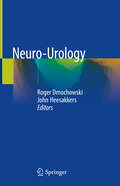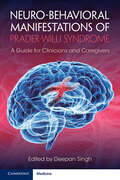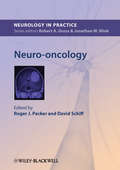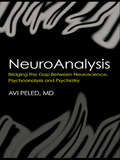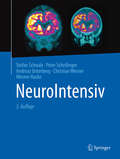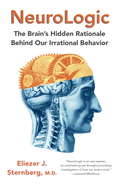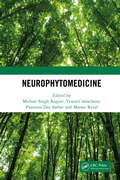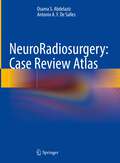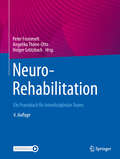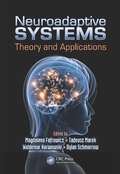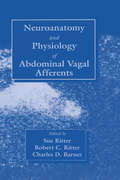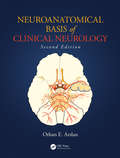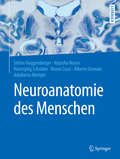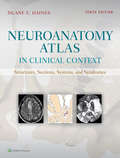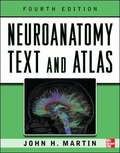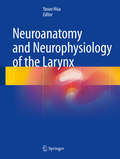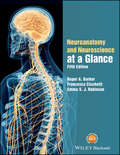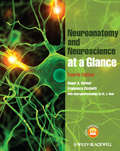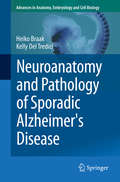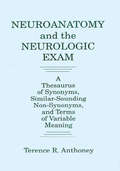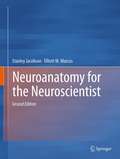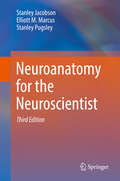- Table View
- List View
Neuro-Urology
by Roger Dmochowski John HeesakkersThis volume is a useful handbook for medical doctors involved in the diagnosis and treatment of neuro-urological problems. The first section reviews the relevant neuro-anatomy and neuro-physiology and provides a practical overview of specific neuro-urological pathologic conditions. The second section discusses the various clinical entities that can be encountered and focuses on the clinical entities neuro-urological consquences. The third section is devoted to the different diagnostic possibilities. Internationally accepted algorithms are presented and put into perspective. Section 4 deals with the triad of major clinical problems in this area: urinary (incontinence, retention and voiding dysfunction as well as upper urinary tract problems), anorectal (faecal incontinence and constipation) and sexual (erectile dysfunction and ejaculatory failure) dysfunctions. The final section covers the specific management of patients with neuro-urological problems and describes conservative and surgical treatments, providing the most recent information. Throughout, the text is accompanied by numerous illustrated case reports and discussions as well as tips and tricks based on the personal experience of the different authors.
Neuro-behavioral Manifestations of Prader-Willi Syndrome: A Guide for Clinicians and Caregivers
by Deepan SinghThe behavioral issues experienced by individuals with Prader-Willi Syndrome (PWS) can be both surprising and overwhelming to clinicians and caregivers. Despite the distress and dysfunction posed by them, there are very few resources available to address these neuropsychiatric problems. This invaluable guidebook helps to identify and address the spectrum of behavioral issues faced by individuals with PWS. Written by a psychiatrist with unique expertise in the management of patients with this condition, this easy-to-read book explores practical details that will aid any clinician or caregiver. Chapters offer vivid case examples and clear guidance on both the behavioral and pharmacological management of issues such as anxiety, skin-picking, ADHD, disruptive behavior (including non-suicidal self-harm), mood disorders (including depression and bipolar disorder), and psychosis. Neuro-behavioral Manifestations of Prader-Willi Syndrome serves as an essential and practical companion for any caregiver or healthcare professional providing care to people with PWS.
Neuro-oncology
by David Schiff Roger R. PackerThe aim of the Neurology in Practice series is to provide a clinical 'in the office' or 'at the bedside' guide to effective patient care for neurologists in practice and in training. The tone will be practical, not academic. The working assumption is that readers want to know what (and what not) might or should be done, without over emphasis on the why. That said, it is important to review the crucial basic science necessary for effective diagnosis and management, and to provide reminders in the context of the practical chapters. The books will not be heavily referenced, in line with a more practical approach. This allows for smoother reading (and also relieves the burden of comprehensive citing from authors). Key evidence (clinical trials, Cochrane or other meta analyses) should be summarized in 'Evidence at a Glance' boxes and key references such as reviews, major papers can be provided in the 'selected bibliography' at the end of each chapter. Practical guidance will be provided through: the use of algorithms and guidelines where they are appropriate 'Tips and Tricks' boxes - hints on improving outcomes perhaps via practical technique, patient questioning etc 'Caution' warning boxes - hints on avoiding problems, perhaps via contraindications 'Science Revisited' - quick reminder of the basic science principles necessary for understanding
Neuro-ophthalmic Disorders (Current Practices in Ophthalmology)
by Preeti Patil ChhablaniThis book discusses in detail the major advances in the field of neuro-ophthalmology. Based on the latest research from across the globe, it highlights recent developments in all areas of neuro-ophthalmology, including optic neuritis and the associated demyelinating diseases – especially the changing paradigms in the diagnosis and management of multiple sclerosis and neuromyelitis optica. It also covers the various types of hereditary optic neuropathies as well as nystagmus and its management. In order to provide comprehensive information in a single volume, it addresses topics of interest in pediatric neuro-ophthalmology, such as pediatric optic neuritis and cortical visual impairment, innovations in the management of ocular motility disorders and other disorders of the optic nerve and central nervous system, including ischemic neuropathies and idiopathic intracranial hypertension.This book provides a one-stop source of information on all key topics of neuro-ophthalmology, enabling trainee fellows and practitioners to keep abreast of the current thoughts in this field.As part of the series “Current Practices in Ophthalmology” this volume is intended for residents and fellows-in-training, as well as generalist and specialist ophthalmologists alike.
NeuroAnalysis: Bridging the Gap between Neuroscience, Psychoanalysis and Psychiatry
by Avi PeledNeuroAnalysis investigates using the neural network and neural computation models to bridge the divide between psychology, psychoanalysis, and neuroscience when diagnosing mental health disorders and prescribing treatment. Avi Peled builds on Freud's early attempts to explain the neural basis of mental health by introducing neural computation as a bridging science to explain psychiatric disorders. Peled describes the brain as a complex system of interconnected units and goes on to suggest that conscious experience, feelings, and mood are emergent properties arising from these complex organisations. This model describes mental health disorders in terms of perturbation to the optimal brain organisation, and demonstrates how particular disorders can be identified through a specific breakdown pattern of the brain’s organisation. This fresh approach to the diagnosis of psychiatric disorders will interest students, professors, and researchers of psychoanalysis, neuroscience, and their related fields.
NeuroIntensiv
by Stefan Schwab Werner Hacke Peter Schellinger Christian Werner Andreas UnterbergIn diesem Nachschlagewerk finden Sie als Intensivmediziner auf einer neurologischen oder neurochirurgischen Intensivstation das spezielle intensivmedizinischen zur Versorgung Ihrer Patienten: Neuroprotektion, Neuromonitoring sowie die Prinzipien der Diagnostik und Therapie spezieller neurologischer Krankheitsbilder sind systematisch und praxisnah beschrieben sowie wissenschaftlich fundiert dargestellt. Die 3. Auflage wurde komplett aktualisiert und um die Themen Dysphagiemanagement sowie PRES, RCVS erweitert. Das erfahrene und interdisziplinäre Herausgeberteam aus Neurologen, Neurochirurgen und Anästhesisten garantiert ,,Know- how" auf höchstem Niveau: perfekt als Praxisbuch und Nachschlagewerk.
NeuroLogic
by Eliezer SternbergA groundbreaking investigation of the brain's hidden logic behind our strangest behaviors, and of how conscious and unconscious systems interact in order to create our experience and preserve our sense of self. From bizarre dreams and hallucinations to schizophrenia and multiple personalities, the human brain is responsible for a diverse spectrum of strange thoughts and behaviors. When observed from the outside, these phenomena are often written off as being just "crazy," but what if they were actually planned and logical? NeuroLogic explores the brain's internal system of reasoning, from its unconscious depths to conscious decision making, and illuminates how it explains our most outlandish as well as our most stereotyped behaviors. From sleepwalking murderers, contagious yawning, and the brains of sports fans to false memories, subliminal messages, and the secret of ticklishness, Dr. Eliezer Sternberg shows that there are patterns to the way the brain interprets the world---patterns that fit the brain's unique logic. Unraveling these patterns and the various ways they can be disturbed will not only alter our view of mental illness and supernatural experience, but will also shed light on the hidden parts of ourselves. (With black-and-white illustrations throughout.)From the Hardcover edition.
NeuroLogic: The Brain's Hidden Rationale Behind Our Irrational Behavior
by Eliezer SternbergA groundbreaking investigation of the brain's hidden logic behind our strangest behaviors, and of how conscious and unconscious systems interact in order to create our experience and preserve our sense of self. From bizarre dreams and hallucinations to schizophrenia and multiple personalities, the human brain is responsible for a diverse spectrum of strange thoughts and behaviors. When observed from the outside, these phenomena are often written off as being just "crazy," but what if they were actually planned and logical? NeuroLogic explores the brain's internal system of reasoning, from its unconscious depths to conscious decision making, and illuminates how it explains our most outlandish as well as our most stereotyped behaviors. From sleepwalking murderers, contagious yawning, and the brains of sports fans to false memories, subliminal messages, and the secret of ticklishness, Dr. Eliezer Sternberg shows that there are patterns to the way the brain interprets the world---patterns that fit the brain's unique logic. Unraveling these patterns and the various ways they can be disturbed will not only alter our view of mental illness and supernatural experience, but will also shed light on the hidden parts of ourselves. (With black-and-white illustrations throughout.)From the Hardcover edition.
NeuroPhytomedicine
by Mithun Singh Rajput Tewarit Sarachana Purnima Dey Sarkar Manan RavalNeurological disorders categorized as neurodegenerative, neuropsychiatric, and neurotraumatic impose a substantial health burden and cause a frail impact on life attributes. The use of synthetic drugs can have undesirable side effects, making neurotherapeutics challenging. Research on neuroprotection aiming for the utilization of safer natural compounds; phytochemicals specifically – is a cutting-edge approach. NeuroPhytomedicine intends to present readers with a wide-ranging and state-of-the-art appearance at the beneficial properties of phytochemicals on various neurological ailments. It additionally contains sections explaining: • Applications of phyto-nanotechnology in neurological ailments, • Phytoconstituents related deep learning and machine learning-based solutions for neurological disorders, • Epigenetic relevance pertaining to modulation by phytochemicals. The goal of NeuroPhytomedicine is to give readers a thorough and up-to-date look at how phytochemicals affect the brain and neurological illnesses in a way that is helpful for research scholars, academicians, scientists, neuroscientists, physicians, and researchers from the pharmaceutical industry.
NeuroRadiosurgery: Case Review Atlas
by Osama S. Abdelaziz Antonio A.F. De SallesThis book is one-of-a-kind comprehensive Radiosurgery Case Review Atlas that includes not only cranial and spinal cases, but also structural and functional radiosurgery ones. It categorizes the various radiosurgery-treated pathologies, presenting illustrative case reviews for each category. Each case includes a clinical summary, a treatment protocol, a radiosurgery dosimetry summary, the pre-radiosurgery images and the serial, short-term and long-term, follow up images illustrating the clinical and radiologic outcomes of the radiosurgery treatment. Offering the readers a handy step-by-step practical guide to perform safe and effective radiosurgery treatment, this will be a useful toolkit for neurosurgeons, radiation neuro-oncologists and radiation physicists (Radiosurgeons) conducting radiosurgery programs or involved in radiosurgery training.
NeuroRehabilitation: Ein Praxisbuch für interdisziplinäre Teams
by Holger Grötzbach Peter Frommelt Angelika Thöne-OttoDas Praxisbuch der Neurorehabilitation…… komplett aktualisiert und überarbeitet: Das große Praxisbuch bietet Grundlagen- und Praxiswissen, detailliert, kritisch, verständlich und an den Bedürfnissen der Patienten orientiert – ein rundum alltagstaugliches Arbeitsbuch für Teams, ein Lehrbuch für die Aus- und Weiterbildung. Mit neuen Kapiteln u.a. zu Telerehabilitation und der Umsetzung spezieller Therapieformen wie Virtual Reality, musikgestützte Therapie, Natur und Tiere.Umfassend: Mit ausführlicher Darstellung der Grundlagen und der Tätigkeitsfelder, beginnend von der Behandlung auf der Stroke Unit bis hin zur Rückkehr in Familie und Beruf.Interdisziplinär: Die gemeinsame Ausbildungs – und Arbeitsgrundlage für alle Berufsgruppen, die in interdisziplinären Teams zusammenarbeiten: Ärzte, Pflegekräfte, Physiotherapeuten, Ergotherapeuten, Logopäden, Neuropsychologen, Sozialpädagogen, Musiktherapeuten u.a.Aktuell: Wissenschaftlich, evidenzbasiert, durchgängig mit bio-psycho-sozialer Orientierung und von den Prinzipien der ICF (Internationale Klassifikation der Funktionsfähigkeit, Behinderung und Gesundheit) geleitet.Kompetent: Fundiertes Fachwissen aus langjähriger Erfahrung, vermittelt von über 50 renommierten internationalen Autoren (aus Deutschland, Schweiz, Großbritannien, Finnland, USA).Informativ: Auch mit Reflexionen über Themen wie „Kontextsensitive Neurorehabilitation“ „Teamarbeit und Zielsetzung“, „Sexualität“, „ Identität und Biografie“, „Holistische neuropsychologische Rehabilitation“.Leserfreundlich: Leicht zugänglich mitEinheitlicher Aufbau der Kapiteloptischer Textstrukturierung: mit Trailers, Praxistipps, Übersichtsboxen, Exkursen („Näher betrachtet“) und mehr…
Neuroadaptive Systems: Theory and Applications (Ergonomics Design & Mgmt. Theory & Applications)
by Waldemar Karwowski Tadeusz Marek Dylan Schmorrow Magdalena FafrowiczBroadly defined as the science and technology of systems responding to neural processes in the brain, neuroadaptive systems (NASs) has become a rapidly developing area of study. One of the first books available in this emerging area, Neuroadaptive Systems: Theory and Applications synthesizes knowledge about human behavior, cognition, neural process
Neuroanat and Physiology of Abdominal Vagal Afferents
by Charles D. Barnes Sue Ritter Robert C. RitterNeuroanatomy and Physiology of Abdominal Vagal Afferents provides a concise, up-to-date selection of focused reviews of vagal sensory participation in control of gastrointestinal function and behavior. The articles, written by internationally recognized leaders in the field, examine the types of information carried by vagal sensory neurons from the gastrointestinal tract, how the vagal sensory and motor components are arranged and interact with the brain, and the nature of vagal sensory participation in selected aspects of physiology and behavior. Future avenues of research in the area of vagal neuroanatomy and physiology are suggested.Neuroanatomy and Physiology of Abdominal Vagal Afferents is a detailed, informative volume that will benefit neurobiologists, GI physiologists, behavioral scientists, and research gastroenterologists.
Neuroanatomical Basis of Clinical Neurology
by Orhan E. ArslanBridging the gap between the peripheral and central nervous systems, the second edition of Neuroanatomical Basis of Clinical Neurology enriches understanding of neurological conditions through a conceptual approach to neuronal circuitry. The book retains the basic outline of contents from the first edition, integrating structural organization with
Neuroanatomie des Menschen (Springer-Lehrbuch)
by Adalberto Merighi Stefan Huggenberger Natasha Moser Hannsjörg Schröder Bruno Cozzi Alberto GranatoAlle prüfungsrelevanten Inhalte der Neuroanatomie für die Vorklinik sind in diesem Buch übersichtlich, kompakt und verständlich erklärt. Viele klinische Beispiele schlagen die Brücke zur späteren Berufspraxis. Die durchdachte Didaktik hilft beim schnellen Verständnis und einfachen Lernen. Profitieren Sie von der langjährigen Erfahrung der Dozenten, die sorgfältig das Wesentliche für Sie ausgewählt und aufbereitet haben.
Neuroanatomy Atlas in Clinical Context: Structures, Sections, Systems, and Syndromes
by Duane E. HainesNeuroanatomy Atlas in Clinical Context is unique in integrating clinical information, correlations, and terminology with neuroanatomical concepts. It provides everything students need to not only master the anatomy of the central nervous system, but also understand its clinical relevance – ensuring preparedness for exams and clinical rotations. This authoritative approach, combined with salutary features such as full-color stained sections, extensive cranial nerve cross-referencing, and systems neurobiology coverage, sustains the legacy of this legendary teaching and learning tool.
Neuroanatomy Guidance to Successful Neurosurgical Interventions: The Torch of Neurosurgical Excellence
by Vladimír Beneš Imad N. KanaanThis unique book covers a wide spectrum of neurosurgical science and practice. Authored by world-renowned neurosurgeons, it aims to bridge the gap between practical anatomy and the recent advances in neurosurgical interventions. A special section on neurovascular surgery demonstrates the surgical skills required and challenges faced during surgery of complex aneurysms, vascular malformations and options for special revascularization procedures. Distinctive chapters highlight the anatomical landmarks for tailored microsurgical and endoscopic approaches to skull base, ventricular and spinal tumors. This textbook outline the role of white matter dissection in glioma and epilepsy surgery with an update on functional and peripheral nerves neurosurgery and a special chapter on the anticipation and management of complications in adult and paediatric neurosurgery.
Neuroanatomy Text and Atlas (4th Edition)
by John H. MartinA regional and functional approach to learning human neuroanatomy <p><p> A Doody's Core Title for 2015!<p> Neuroanatomy:Text and Atlas covers neuroanatomy from both a functional and regional perspective to provide an understanding of how the components of the central nervous system work together to sense the world around us, regulate body systems, and produce behavior. This trusted text thoroughly covers the sensory, motor, and integrative skills of the brains and presents an overview of the function in relation to structure and the locations of the major pathways and neuronal integrative regions. <p> Neuroanatomy:Text and Atlas also teaches you how to interpret the new wealth of human brain images by developing an understanding of the anatomical localization of brain function. The authoritative core content of myelin-stained histological sections is enhanced by informative line illustrations, angiography, and brain views produced by MRI, and other imaging technologies. <p> NEW to this edition: <p> Revised and updated to reflect advances in clinical neuroanatomy and neural science<br> Full-color illustrations have been added to enrich the text<br> Chapters begin with a clinical case to illustrate the connections and functions of the key material<br> Chapters end with a series of multiple-choice review questions<br> <p>Features and Benefits: <p> Increases knowledge of the regional and functional organization of the spinal cord and brain, one system at a time<br> Provides thorough coverage of the sensory, motor, and integrative systems of the brain, together with cerebral vasculature<br> Promotes understanding of the complex details of neuroanatomy needed for accurate interpretation of radiological image<br> Comprehensive atlas provides key views of the surface anatomy of the central nervous systems and photographs of myelin-stained sections in three anatomical planes<br> Includes learning aids such as clinical topics, boxes, chapter summaries, and a Glossary of key terms and structures
Neuroanatomy and Neurophysiology of the Larynx
by Yasuo HisaThis book is a concise but detailed treatise on the laryngeal nervous system. It is ideal for researchers starting work in this field in that it provides a quick update on present-day basic neurolaryngology. A brief introduction to the methodology that made recent progress possible is followed by a review of classical basic neuroanatomy and neurophysiology. Additionally, the book provides some of the most recent findings in neurolaryngology. The many illustrative figures and microscopic photographs help readers to achieve a clearer understanding of the text and ample references provide links to further reading in specific areas of the field. The book contains much general material that will be instructive even for researchers not specializing in basic neurolaryngology and will provide an essential grounding for clinicians in laryngology.
Neuroanatomy and Neuroscience at a Glance
by Roger A. Barker Francesca Cicchetti Emma S. RobinsonEverything you need to know about Neuroanatomy and Neuroscience … at a Glance! Neuroanatomy and Neuroscience at a Glance is a highly illustrated, quick reference guide to the anatomy, biochemistry, physiology and pharmacology of the human nervous system. Each chapter features a summary of the anatomical structure and function of a specific component of the central nervous system, a section on applied neurobiology outlining how to approach a patient with neurological or psychiatric problems aligned to the chapter topic, standard diagnostic procedures for most common scenarios, as well as an overview of treatment and management options. This fully updated and expanded new edition includes: Dozens of full-page, colour illustrations and neurological scans Expanded coverage of techniques to study the nervous system More practical information on the neurological exam New content on neuropharmacology and drug therapies Bullet points and bold terms throughout assist with revision and review of the topic Neuroanatomy and Neuroscience at a Glance is the ideal companion for students embarking on a neuroanatomy or neuroscience course, and is an excellent reference tool for those in clinical training.An updated companion website with new clinical cases, multiple choice self-assessment questions, revision slides, and downloadable illustrations and flashcards is available at www.ataglanceseries.com/neuroscience
Neuroanatomy and Neuroscience at a Glance (At A Glance Ser. #85)
by Roger A. Barker Francesca CicchettiNeuroanatomy and Neuroscience at a Glance provides a user-friendly introduction to the anatomy, biochemistry, physiology and pharmacology of the human nervous system within one, succinct, highly-illustrated volume. The double page spreads begin by summarising the anatomical structure and function of the different components of the central nervous system, followed by a section on applied neurobiology which outlines how to approach the patient with neurological and psychiatric problems and provides an overview of treatment and management options. Key features of this fourth edition include: A manageable overview of the structure and function of the central nervous system Full guidance on how to approach the patient with neurological problems and the investigations used in the most common scenarios Cases highlighting the clinical relevance of the basic neuroscience New chapters on the major neurotransmitters of the CNS and their functions, the enteric nervous system and stroke A fully updated companion website with interactive self-assessment questions and case studies, flashcards and revision notes at www. ataglanceseries. com/neuroscience Neuroanatomy and Neuroscience at a Glance is the ideal companion for anyone about to start a basic neuroanatomy or neuroscience course, or can be used as a refresher for those in clinical training.
Neuroanatomy and Pathology of Sporadic Alzheimer's Disease
by Heiko Braak Kelly Del TrediciAs indicated by its title, this monograph deals chiefly with morphologically recognizable deviations from the normal anatomical condition of the human CNS. The AD-associated pathology is illustrated from its beginnings (sometimes even in childhood) to its final form, which is reached late in life. The AD process commences much earlier than the clinically recognizable phase of the disorder, and its timeline includes an extended preclinical phase. The further the pendulum swings away from the symptomatic final stages towards the early pathology, the more obvious the lesions become, although from a standpoint of severity they are more unremarkable and thus frequently overlooked during routine neuropathological assessment. For this reason, the authors deal with the hallmark lesions in the early phases of the AD process in considerable detail
Neuroanatomy and the Neurologic Exam: A Thesaurus of Synonyms, Similar-Sounding Non-Synonyms, and Terms of Variable Meaning
by TerenceR. AnthoneyIn this book!Neuroanatomy and the Neurologic Exam is an innovative, comprehensive thesaurus that surveys terminology from neuroanatomy and the neurologic examination, as well as related general terms from neurophysiology, neurohistology, neuroembryology, neuroradiology, and neuropathology. The author prepared the thesaurus by examining how terms were used in a large sample of recent, widely used general textbooks in basic neuroanatomy and clinical neurology. These textbooks were written by experts who received their primary professional training in 13 different countries, allowing the thesaurus to incorporate synonyms and conflicting definitions that occur as a result of variations in terminology used in other countries. The thesaurus contains:
Neuroanatomy for the Neuroscientist
by Stanley Jacobson Elliott M. MarcusIn this day where research grants are the primary focus, many young investigators are thrown into neurosciences courses without any prior preparation in neuroanatomy. This book is designed to help prepare them by introducing many of the fundamentals of the nervous system. It represents the essentials of an upper level biology course on the central nervous system. It is not designed to be a clinical approach to the nervous system, but rather it approaches the nervous system from a basic science perspective that intertwines both structure and function as an organizing teaching and learning model. Medical and dental examples are included but the main focus is on neuroscience.
Neuroanatomy for the Neuroscientist
by Stanley Jacobson Elliott M. Marcus Stanley PugsleyThe purpose of this textbook is to enable a Neuroscientist to discuss the structure and functions of the brain at a level appropriate for students at many levels of study including undergraduate, graduate, dental or medical school level. It is truer in neurology than in any other system of medicine that a firm knowledge of basic science material, that is, the anatomy, physiology and pathology of the nervous system, enables one to readily arrive at the diagnosis of where the disease process is located and to apply their knowledge at solving problems in clinical situations. The authors have a long experience in teaching neuroscience courses at the first or second year level to medical and dental students and to residents in which clinical information and clinical problem solving are integral to the course.
